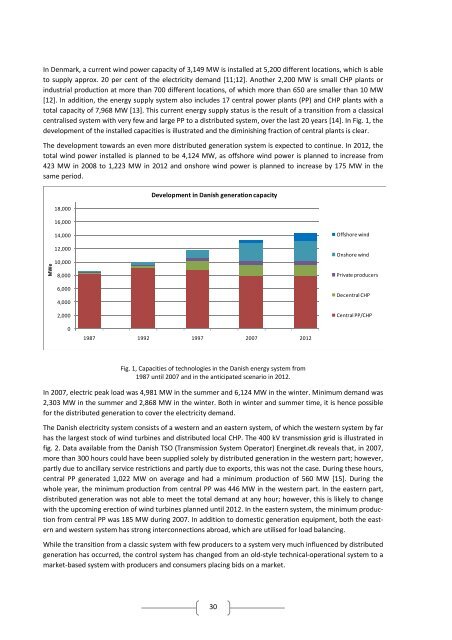Fuel cells and electrolysers in future energy systems - VBN
Fuel cells and electrolysers in future energy systems - VBN
Fuel cells and electrolysers in future energy systems - VBN
Create successful ePaper yourself
Turn your PDF publications into a flip-book with our unique Google optimized e-Paper software.
In Denmark, a current w<strong>in</strong>d power capacity of 3,149 MW is <strong>in</strong>stalled at 5,200 different locations, which is able<br />
to supply approx. 20 per cent of the electricity dem<strong>and</strong> [11;12]. Another 2,200 MW is small CHP plants or<br />
<strong>in</strong>dustrial production at more than 700 different locations, of which more than 650 are smaller than 10 MW<br />
[12]. In addition, the <strong>energy</strong> supply system also <strong>in</strong>cludes 17 central power plants (PP) <strong>and</strong> CHP plants with a<br />
total capacity of 7,968 MW [13]. This current <strong>energy</strong> supply status is the result of a transition from a classical<br />
centralised system with very few <strong>and</strong> large PP to a distributed system, over the last 20 years [14]. In Fig. 1, the<br />
development of the <strong>in</strong>stalled capacities is illustrated <strong>and</strong> the dim<strong>in</strong>ish<strong>in</strong>g fraction of central plants is clear.<br />
The development towards an even more distributed generation system is expected to cont<strong>in</strong>ue. In 2012, the<br />
total w<strong>in</strong>d power <strong>in</strong>stalled is planned to be 4,124 MW, as offshore w<strong>in</strong>d power is planned to <strong>in</strong>crease from<br />
423 MW <strong>in</strong> 2008 to 1,223 MW <strong>in</strong> 2012 <strong>and</strong> onshore w<strong>in</strong>d power is planned to <strong>in</strong>crease by 175 MW <strong>in</strong> the<br />
same period.<br />
MWe<br />
18,000<br />
16,000<br />
14,000<br />
12,000<br />
10,000<br />
8,000<br />
6,000<br />
4,000<br />
2,000<br />
0<br />
Development <strong>in</strong> Danish generation capacity<br />
1987 1992 1997 2007 2012<br />
Fig. 1, Capacities of technologies <strong>in</strong> the Danish <strong>energy</strong> system from<br />
1987 until 2007 <strong>and</strong> <strong>in</strong> the anticipated scenario <strong>in</strong> 2012.<br />
30<br />
Offshore w<strong>in</strong>d<br />
Onshore w<strong>in</strong>d<br />
Private producers<br />
Decentral CHP<br />
Central PP/CHP<br />
In 2007, electric peak load was 4,981 MW <strong>in</strong> the summer <strong>and</strong> 6,124 MW <strong>in</strong> the w<strong>in</strong>ter. M<strong>in</strong>imum dem<strong>and</strong> was<br />
2,303 MW <strong>in</strong> the summer <strong>and</strong> 2,868 MW <strong>in</strong> the w<strong>in</strong>ter. Both <strong>in</strong> w<strong>in</strong>ter <strong>and</strong> summer time, it is hence possible<br />
for the distributed generation to cover the electricity dem<strong>and</strong>.<br />
The Danish electricity system consists of a western <strong>and</strong> an eastern system, of which the western system by far<br />
has the largest stock of w<strong>in</strong>d turb<strong>in</strong>es <strong>and</strong> distributed local CHP. The 400 kV transmission grid is illustrated <strong>in</strong><br />
fig. 2. Data available from the Danish TSO (Transmission System Operator) Energ<strong>in</strong>et.dk reveals that, <strong>in</strong> 2007,<br />
more than 300 hours could have been supplied solely by distributed generation <strong>in</strong> the western part; however,<br />
partly due to ancillary service restrictions <strong>and</strong> partly due to exports, this was not the case. Dur<strong>in</strong>g these hours,<br />
central PP generated 1,022 MW on average <strong>and</strong> had a m<strong>in</strong>imum production of 560 MW [15]. Dur<strong>in</strong>g the<br />
whole year, the m<strong>in</strong>imum production from central PP was 446 MW <strong>in</strong> the western part. In the eastern part,<br />
distributed generation was not able to meet the total dem<strong>and</strong> at any hour; however, this is likely to change<br />
with the upcom<strong>in</strong>g erection of w<strong>in</strong>d turb<strong>in</strong>es planned until 2012. In the eastern system, the m<strong>in</strong>imum produc‐<br />
tion from central PP was 185 MW dur<strong>in</strong>g 2007. In addition to domestic generation equipment, both the east‐<br />
ern <strong>and</strong> western system has strong <strong>in</strong>terconnections abroad, which are utilised for load balanc<strong>in</strong>g.<br />
While the transition from a classic system with few producers to a system very much <strong>in</strong>fluenced by distributed<br />
generation has occurred, the control system has changed from an old‐style technical‐operational system to a<br />
market‐based system with producers <strong>and</strong> consumers plac<strong>in</strong>g bids on a market.

















